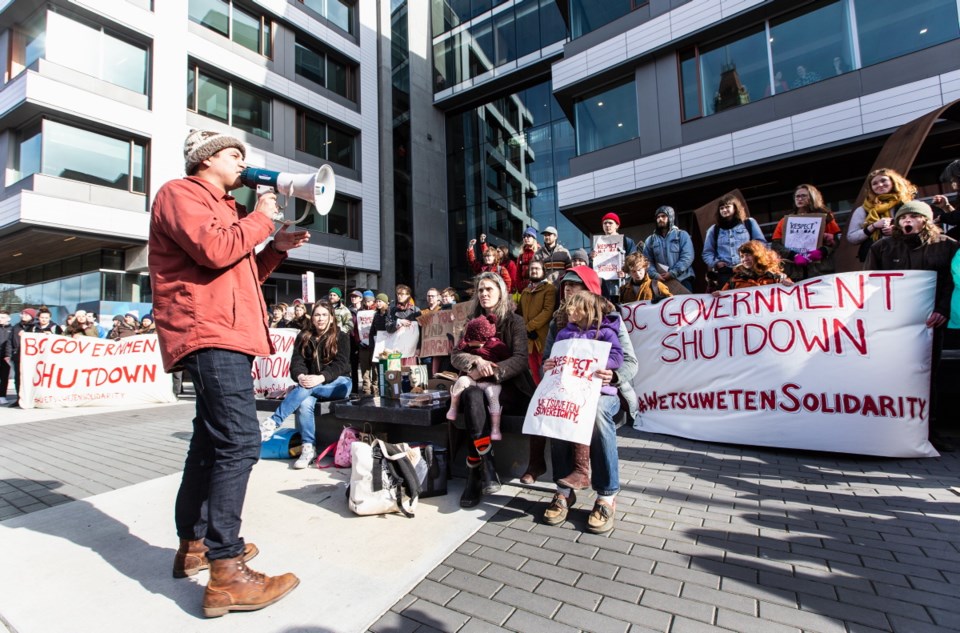Tuesday morning, a group that included a handful of old white guys who looked, well, kind of like me demonstrated outside the Langford home of Premier John Horgan.
In doing so they invoked the name of the Wet’suwet’en, to which the obvious question is: Which ones?
For despite the best efforts of outsiders who would weaponize the Wet’suwet’en for their own purposes, it has become clear that deep divisions exist within that community. The Wet’suwet’en themselves don’t speak with one voice, so how can anyone else presume to stand on behalf of them all?
This applies to both sides of the tug-of-war, those who drag out Indigenous people to justify the gas line they want to see built, and those who do so in opposition. To be blunt, that’s cherry-picking. That’s selectively using Indigenous people as human shields to advance another agenda: climate change, corporate profit, a general-purpose rage against the machine, whatever. They should make a Heritage Minute: paternalism, a Canadian tradition.
It doesn’t help that the narrative has been over-simplified by those on either side and inflamed by social media indignation. To accept that the 20 elected councils along the gas-project route gave the project all the blessing it needs is to ignore the role of the five hereditary chiefs whose opposition has led to the current wave of cross-Canada protests. Yet to argue that elected councils have no legitimacy because they are a construct of the Indian Act, or that they have no say beyond the border of reserves, is a conveniently dismissive approach that ignores the feelings of those who did the electing.
People seeking a deeper understanding of the divisions could do worse than turning to APTN News, which, not surprisingly, offers nuanced perspectives not found in other media or espoused by those who shout loudest.
Among them are arguments advanced by Wet’suwet’en supporters of the pipeline: “Along with revenue from Impact Benefits Agreements and Provincial Pipeline Agreements, Indigenous businesses will benefit from $620 million in contract work for the project’s right-of-way clearing, medical, security and camp management needs. There is another $400 million in additional contract and employment opportunities for Indigenous and local B.C. communities during pipeline construction.”
The implicit message is that when you have spent 150 years on the outside looking in, and finally have a shot at sharing the kind of prosperity enjoyed by others, it’s frustrating to have that threatened by outsiders who were reared in the kind of comfort you were denied.
The counter-argument is that the hereditary chiefs are charged with responsibility for protecting the land, and that can’t simply be ignored — a position that dovetails nicely with that of those whose primary concern is the environment in general and climate change in particular.
The thing is, what happens when such interests clash? Environmental groups already squirm trying to reconcile opposition to logging with Indigenous involvement in �鶹��ýӳ��Island’s forest industry. Several Indigenous groups have expressed interest in investing in another pipeline project, the Trans Mountain expansion. Finance Minister Bill Morneau announced last week that up to 129 First Nations communities will be consulted in the next few weeks to ensure they have a shot at “meaningful economic participation” in Trans Mountain, which the federal government purchased from the private sector in 2018.
“This next step will be focused on different models of economic participation such as equity-based or revenue-sharing options and will seek to build momentum towards a widely acceptable option for the groups that we’re consulting with,” The Canadian Press quoted Morneau as saying.
“We’ll also explore whether the participating communities are willing to work together, either through an existing entity or a new one.”
The hearts and minds tug-of-war continued Tuesday when included among the provincial budget documents was an eight-page backgrounder titled Building the Foundations of Reconciliation. It was more or less a summary of existing initiatives, but included one key phrase: “Indigenous people have the right to the conservation and protection of the environment and the productive capacity of their lands, territories and resources.” What wasn’t clear was who will speak on behalf of Indigenous people, or how differences between and within Indigenous bodies get worked out.
That’s a question more important to some than others. Long after the well-meaning, passionate student protesters have moved on with their lives, long after the ideologues have embarked on the next chapter of their class war, long after the gas companies have made their billions and long after the politicians have turned their focus to the next crisis, the Wet’suwet’en will be left to figure out how to live with one another, how to answer the tricky questions.
They don’t need the advice of you, me, or a bunch of non-Wet’suwet’en blocking the premier’s driveway in their name.



